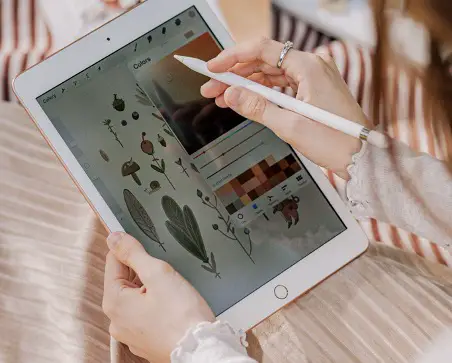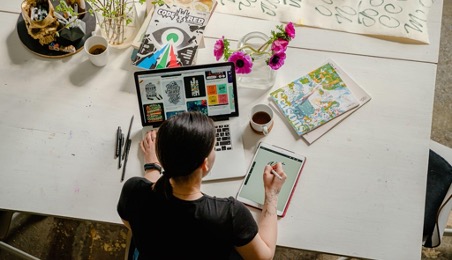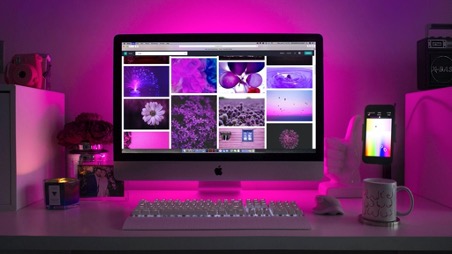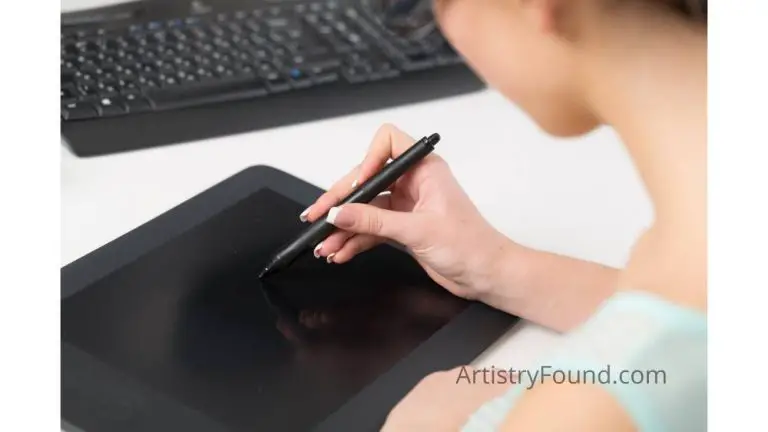How to Do Digital Art? (A Helpful Guide for Beginners)
Digital painting, often known as digital art, has grown in popularity over time. As more businesses move to the digital world, the market for digital art is growing as well.
However, getting started with digital painting might be intimidating at first; therefore, I’ve put together this basic guide to help you get started on the right foot.
What is Digital Art?

(This article may contain affiliate links and I may earn a commission if you make a purchase)
https://www.pexels.com/photo/a-person-holding-an-ipad-and-making-digital-arts-4986496/
Digital painting, often known as digital art, is a method that allows anyone to produce beautiful artwork without using paint or oils.
To create digital art, you must adhere to the same rules that apply to basic or traditional art. Furthermore, digital art is simple to learn. You can even get started creating digital art for free by just using an existing laptop, phone, tablet, or desktop computer.
Since the primary medium of digital art is technology-based you’re able to even take artwork that was created traditionally and move it into a digital workspace. These preliminary works can be scanned into a computer and enhanced and improved.
Digital art can also refer to photography in which digital photographs are modified with a photo manipulation app to make them appear even more incredible. Digital art is widely used in animated works, major feature films, and advertising!
Types of Digital Art

Below are some of the different kinds of art a digital artist can create:
Digital Painting
Digital painting is the practice of painting virtually on a laptop or tablet using painting software. Brushes, pencils, watercolors, erasers, and other classic painting techniques and instruments are used in this software.
Vectors
To create vector art, structured drawing employs mathematically specified forms and strokes known as vectors. You can alter scales without the details pixelating if you use vectors.
3D Modelling & Sculpturing
This ranges from photorealism to low poly artwork and is essentially the process of employing digital tools to add an additional dimension to the artwork.
Pixel and Voxel Art
Pixel and voxel art was popular in computer games in the 1980s and 1990s when color palettes were limited and visible pixels and cubes were used to create graphics.
Isometric Art
This type of digital art gives the idea of seeing an object from all three sides at once.
Isometric digital art was first used by engineers and architects for technical illustrations, but it has since been adopted by artists working in a variety of mediums.
Digital Sculpting
The process of modifying digital things with software is known as digital sculpting. It’s also known as 3D sculpting because it creates 3D objects.
Fontography
Fontography has been given fresh life because of the use of digital tools in fine art photography. Artists can use digital tools to simulate numerous photographic techniques that don’t require a darkroom anymore as long as the correct software program is used.
PhotoBashing
It is the process of combining multiple images in Photoshop to create the illusion of a new photorealistic image.
Integrated Digital Art
Integrated digital art is a form of art that incorporates digital technology into the creative process. This can include anything from using a computer to create artwork, to incorporating digital elements into traditional media such as painting or sculpture.
The goal of integrated digital art is to create something that wouldn’t be possible without the use of digital tools and technology
How is Digital Artwork Made?

https://www.pexels.com/photo/photo-of-woman-writing-on-tablet-computer-while-using-laptop-4348401/
You’ll need a computer or tablet and a drawing program to create your illustrative digital artwork.
You must first grasp how the software and hardware tools function before you can use them. You’ll want to begin with a blank document, regardless of the platform you use to produce the art.
To find a viable design, you generally want to concentrate on a fundamental, rough background sketch.
By making a preliminary sketch, you can eventually generate customized graphics. It is vital to grasp the layers well. Ultimately, depending on your needs, you can continue to add layers. Make sure the layers are appropriately overlaid.
However, it would be beneficial if you avoid overdoing it. Remember to save and export the design after completion. If you have a large file, keep combining layers and saving the files as needed.
Tip:
To get a sense of how your design will look, start by drawing your ideas on paper first. You can use these drawings as inspiration for your digital work or to plan out your ideas.
After that, you’ll need to scan your sketch and start outlining it in Photoshop. Photoshop is a widely used program by artists since it has all the tools necessary for digital art. Next, you can choose to hide (or keep) the pencil sketch layer. This method is useful for total beginners who are unfamiliar with using digital tools. Next, save your work.
Brightness and contrast can be adjusted. After that, just add the colors, layers, and those details. Play with the effects, and you’re done!
Beginners’ Guide to Digital Painting
So, what do you need to create a digital painting?
The first decision you must make is what type of technology you will utilize. Digital art isn’t limited to your computer’s screen. Smartphones, tablets, and laptops are examples of gadgets that can be used for digital art.
The program you use may be determined by your chosen screen configuration or the type of art you want to make. I’ll go over some of the things you should invest in if you decide to turn this hobby into your career.
You’ll just need two items to get started with digital painting: a tablet and some painting software.
Tablets

https://www.pexels.com/photo/person-drawing-a-jack-o-lantern-on-a-tablet-5428663/
There are three types of tablets you can use for creating digital art:
Graphic Tablet
These are the most affordable models, and they’re what most digital artists start with.
The graphic tablet’s objective is to replace a drawing table, a pencil, chalk, or brushes and to make the lives of creative individuals easier by allowing them to save and alter their work without difficulty.
Furthermore, the graphic tablet allows all of the works from an “analog” workshop to be transferred to a digital environment.
They usually consist of simply two parts: a touchpad and a stylus (a digital pen), though more expensive models may include a number of buttons and dials on the side. Because these tablets don’t have screens, you’ll need to connect them to a laptop or PC.
Here’s an example of a highly rated, yet inexpensive graphic tablet on Amazon.com
Pros
- The most affordable option, which is quite sufficient for getting started.
- Simple functionality, yet sufficient for professional work
- Since they have few fragile pieces, they are usually exceedingly strong and long-lasting.
- There are no batteries or charging required.
- No screen to damage
- The majority are lightweight and tiny enough to be easily transported.
- When utilizing a graphics tablet, finding a good seating posture is considerably easier.
Cons
- Requires the use of a computer
- It takes some practice to draw on the tablet while looking up at your monitor.
- When opposed to a screen tablet, line drawing on a graphics tablet is less accurate.
- Because you can’t draw lines with your elbow and shoulder on very small graphics tablets, they can create wrist problems over time.
Display Tablet
If you have a bit higher budget, however, you should choose a display tablet. They are similar to graphic tablets but they have a built-in monitor. You will be more satisfied in your learning process because you can see what you’re drawing.
A popular display tablet is the XP-PEN Artists 13.3 Pro (Amazon). This tablet comes in various sizes and is intuitive to use.
Pros
- Working on a screen feels more natural than working on a tablet without one because it’s nearly like drawing on a piece of digital paper.
- Makes it possible for you to work more precisely
- When not being used for art, it can be utilized as a monitor.
Cons
- Much more expensive than tablets with no screen
- Because they feature more moving and fragile elements than a screenless tablet, they are less durable.
- Only the smallest screen tablets are somewhat portable, and they must be used in conjunction with a computer.
- Over time, ‘dead pixels’ may appear.
- Requires the use of a computer
All-in-One Tablet
Two of the most popular tablets are the iPad Pro and the Microsoft Surface Pro (both at Amazon) fall within this category. These are the priciest tablets available. One of the most significant advantages of these tablets is that you may view your drawings without having to connect them to a separate computer.
They are also one of the most portable devices due to their minimal weight. When using an iPad, it’s very important to use the stylus carefully across the screen, however.
Pros
- Drawing on a computer screen is more natural than using a touchpad.
- You don’t need to bring a laptop with you because it is a portable computer in and of itself.
Cons
- All-in-One tablets can get pricey
Digital Painting Software

https://www.pexels.com/photo/turned-on-screen-silver-macbook-air-on-wooden-desk-56759/
When it comes to making digital art, there is numerous digital art software to select from. The software will assist you in creating whatever form of digital art you want in various ways.
The following is a list of software that is suggested for beginners to creating digital art:
Adobe Photoshop
Adobe Photoshop is likely the most favored software because it has the features and tools most digital artists need. Various brushes with a variety of settings can be tweaked until the perfect tool is found. It also offers a nearly limitless color palette, offers layer functionality, and is a fantastic tool for 3D digital painting and photo editing.
Adobe Photoshop is one of the programs available in the Adobe Creative Suite, which includes a number of other products (for example, adobe illustrator) to help you along your digital creative journey.
All of these digital painting programs have a free week trial so that you can try them out prior to purchase. Students will receive a substantial discount on their subscriptions.
If you’re passionate about digital painting, Adobe Photoshop is a great place to start. It’s the most powerful painting software available, and because it’s the most popular choice, there is a ton of training and tutorials for its use available online.
Affinity
If you’re on a tighter budget and don’t want to subscribe to Photoshop, Affinity is a company that creates multiple digital software apps. It is far less expensive than Adobe and comes with a free trial, so you can try out all the apps before shelling out any money.
All of your image editing needs may be met with Affinity Photo.
Affinity Designer, on the other hand, is ideal for digital painting, drawing, and illustration. It is simple to use and ideal for novices, as it is not as complicated as Photoshop. It’s also a lot less expensive, costing only $24.99 for a one-time purchase.
Affinity is an affordable alternative to Photoshop, with a huge amount of features.
ProCreate
ProCreate has completely dominated the digital painting business. ProCreate is one of the most artist-friendly software platforms known.
Although some Photoshop capabilities may not be available in ProCreate, you can still make a stunning drawing with the features included.
Note, however, that it is an app that can only be used on iPads and iPhones.
Dozens of unique brushes, a rich color palette, and the capacity to do just about anything you can imagine are all available in this digital art program. Illustrations, paintings, animations, and more can be done with Procreate.
Krita
Since it is free, many newbie digital artists prefer Krita. It is, without a doubt, one of the best open-source Photoshop alternatives. However, there aren’t as many digital art tutorials available for digital painting using Krita as you may like.
If you want to pursue a professional career in digital art, Krita is a good place to start.
Gimp
Another free, open-source application is Gimp. It’s similar to Photoshop, but the user interface isn’t quite as nice. The design is a little odd and occasionally flaky, so this program takes some getting accustomed to.
However, if you’re looking for a free tool, Gimp is a good option. If you take the time to learn the shortcuts and the interface, you can do a lot with this software.
Importance of Digital Art

https://www.pexels.com/photo/silver-imac-displaying-collage-photos-1779487/
Convenient and Efficient
Digital art is more convenient because it does not require a large art studio with tools. Digital artworks are also easier to store and deliver.
It’s also more efficient because you can start working whenever the creative flow strikes you, regardless of where you are. Furthermore, you are not required to clean up after completing your work; all you need to do is save your work and switch off the computer.
Corrections are Simple to Make
You can easily redraw or revise your work, and if you make a mistake, you can undo it.
More Tools are Accessible
You can choose from a range of brushes, use all of the colors available, and use geometric tools.
No Need to Spend Money on Art Supplies
Although digital art is pricey at first, it is rarely necessary to replace objects. The pen nib will most likely be the only item you have to buy again and again. As a result, it is extremely cost-effective in the long run.
You can relax and draw because you won’t waste paper, canvas, paint, or ink if you make a mistake.
Tracing is A Lot Easier
You can start tracing right away in a digital space by creating a new layer above it. You can also change how much of the original image is visible (opacity).
Great for Novices
For a novice digital illustrator, it is very freeing to be able to work on creating whatever you want without being worried about making a mistake while first learning the tools. If you don’t like what you’ve made, you can just start over. It removes much of the frustration.
Digital Art Tips
- Make use of a pressure-sensitive drawing tablet.
- Get to know the basic tools.
- Use as few brushes/pencils/etc. as possible.
- Use layers to your advantage.
- Don’t become overly reliant on ctrl + z (Undo).
- Warm-up with basic exercises.
- Sketch on a regular basis.
- Practice your figure drawing.
- Make a list of shortcuts and put them to the test.
- Improve your portraiture skills.
- Improve your ability to draw characters.
- Customize your workspace.
- Learn how to set up a document and export it.
FAQs
What Technologies are Used in Digital Painting?
It’s a medium that consists of a computer, a graphics tablet, and the software of one’s choice. To produce 2D paintings with digital art software, the artist uses painting and drawing skills with the stylus that is included with the graphics tablet.
What Do the Majority of Artists Use to Create Digital Art?
Adobe Photoshop is without a doubt the most favored and frequently used program in the field of digital art. It’s packed with features and is continuously updated, allowing you to produce everything from concept prototypes to comic covers to photo-emulated artwork.
What Distinguishes Digital Art from Traditional Drawing?
Traditional art uses common techniques that have existed for sometimes hundreds of years, and have been developed and perfected over time. Digital art, on the other hand, creates art using digital technologies.
Is Digital Art Difficult?
Since digital art requires an entirely different skill set than traditional art, it can be difficult. When switching to a digital art medium and having to relearn the basics, many experienced artists realize they’re back to square one. Once you get used to it, however, creating digital art can be a lot of fun.
How to Do Digital Art – Final Word
There is something for everyone in the field of digital art, whether it’s digital painting, photo painting, digital photography, or one of the many other varieties. You must first understand what to choose and which strategy is ideal for you while staying within your budgetary constraints.
If you love creating digital art, you can always elect to invest more. Art isn’t a competition; you can go at your own pace.
I hope you found this post helpful and that it has aided you in taking your first steps into digital art. I wish you much joy in creating new digital artwork!






